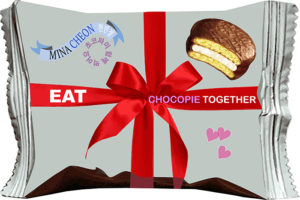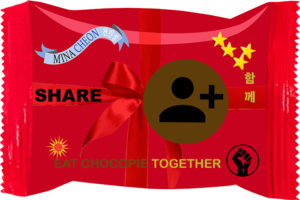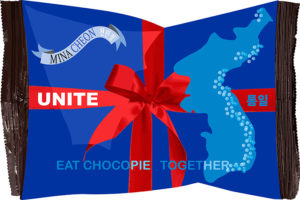Mina Cheon





The five Chocopie designs by the artist Mina Cheon: EAT, LOVE, PEACE, SHARE, UNITE.
“Eat Chocopie Together is about art promoting peace and healing. As the Chocopie has become the cultural symbol of inter-Korean unification efforts, from the Koreas to the world, I hope that every bite taken is one towards global peace, love and kindness.” (Mina Cheon)
“Can Choco Pies—the delectable marshmallowy snack cake—bring us closer together? The artist Mina Cheon hopes so, and in collaboration with the Asia Society Triennial, she has launched a new digital initiative dubbed Eat Chocopie Together, in which she implores the public to share the treat virtually with a friend “for global peace”, to help those affected by the coronavirus and to combat anti-Asian racism.” (The Art Newspaper, August 17, 2020)

Front page of EatChocopieTogether.com.
Korean New Media artist Mina Cheon trailblazes the virtual worlds to make it possible for people to connect with her online “Eat Chocopie Together” digital art initiative. Kicking off the inaugural Asia Society Triennial “We Do Not Dream Alone,” in collaboration with Asia Society Museum in New York, the new digital platform EatChocopieTogether.com allows anyone to pick a Chocopie from a map of Korea and send it electronically with a message to a loved one. By sharing virtual Chocopies with others, not only are we staying virtually connected during a time of social distancing, donations are automatically being generated towards a charity to help Korean Americans affected by the coronavirus and to stand against anti-Asian racism through the Korean American Community Foundation Covid-19 Action Fund.

Zoomed in, the Korean peninsula map is being covered with names of those participating and sharing Chocopies. During our physically and socially distanced times, the project is meant to help stay virtually connected.
When people share Chocopies on this site, their names are written on the Korean peninsula as a way to leave imprints declaring peace in Korea and peace on earth. Targeting 5000 people participation to raise $5000, the number 5000 symbolizes the years that the North and South Koreans were united before the division. Moreover, the launching of this project on August 15 Korean Liberation Day from Japanese colonization (1910-1945) highlights the one national holiday celebrated by both Koreas and that when Korea liberated, it was “one Korea.”
And why Chocopies? Chocopies, a South Korean confectionary, became one of the most desirable consumer products in North Korea, after they were gifted by South Korean workers to their peers from the North at the jointly managed Kaesong Industrial Complex prior to its closure in 2013. In 2014, this treat was banned in North Korea, and since then Chocopies have been making it across the border through a number of creative ways. South Korean activists have even used helium balloons to launch thousands of Chocopies over the DMZ border into North Korea, some with messages of love and care.

Eat Chocopie Together, 10,000 Chocopies for the audience to eat, Ethan Cohen Gallery in New York in 2014. Photo courtesy the artist and Ethan Cohen Gallery.
Eat Chocopie Together, as an art installation made of 10,000 Chocopies for the audience to eat, was first shown at Ethan Cohen Gallery in 2014 during Mina Cheon aka Kim Il Soon’s solo exhibition “Chocopie Propaganda: From North Korea with Love.” Sponsored by the manufacturing South Korean company Orion Co., these Chocopies have a rich Korean history tied to love, friendship, and exchange and have become an interKorean peace symbol. When Cheon last showed her Chocopie installation at the 2018 Busan Biennale in Korea, it became a national sensation and even had the South Korean President Moon Jae-in and First Lady Kim Jung-sook eating, amidst Korea’s media buzz and slogan for “A New Future” of Korea.
In collaboration with Asia Society New York and the Asia Society Triennial, their virtual project Eat Chocopie Together is made possible by the Korean Foundation and an anonymous donor to the Korean American Community Foundation (KACF).

Eat Chocopie Together, 100,000 Chocopies for the audience to eat at the Busan Biennale 2018. Chocopies were sponsored by Orion Co. for both exhibitions. Photo courtesy the artist and Busan Biennale 2018, photo by Lee Sang Uk.
Mina Cheon is a Korean new media artist, scholar, and educator who lives and works between Baltimore, New York, and Seoul and exhibits her political pop art known as “Polipop” internationally. As a part of the Korean diaspora, Cheon’s art results from a lifetime of working with a postcolonial and comparative cultural lens. The resulting work is in historic alignment with appropriation art and global activism art and focuses on North Korean awareness, Korean unification, and global peace projects. Her next iteration of these works will be featured during the Asia Society Triennial months through multiple platforms. Cheon is a Full-time Professor at the Maryland Institute College of Art (MICA) of Baltimore, Maryland and lecturer at Ewha Womans University, Seoul, South Korea.